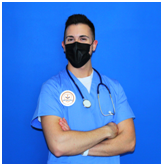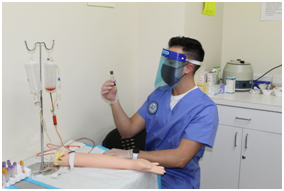High School graduation is upon us! The current high school students fall into the Generation Z bracket, which is defined as individuals born between 1997 and 2012. That means Gen Z is trying to figure out what their next move will be.
A study from ECMC research found that Gen Z are more open to post-secondary education other than 4 year colleges.
According to the study 61% said they believed a “skill-based education,” such as coding, medical assistant school or trade options, would be a sensible career choice.

Healthcare vocational schools such as AIHT Education, located in Stratford Connecticut, provides students with hands-on training for a specific career. Here are a few of the top healthcare careers for high school graduates in 2021.
1. Certified Nursing Assistant (CNA)
Description:
A Certified Nursing Assistant or CNA job responsibility is to give basic medical services to patients in hospitals or nursing homes. Nursing assistants provide basic care and assistance to patients with activities of daily living such as cleaning, feeding and bathing.
Training:
The CNA Training at AIHT Education takes 6 weeks for day classes and 8 weeks for evening classes. The students are going to be given the knowledge and skills necessary to become
licensed as a Nurse Aide within the State of Connecticut.
Professional Credentials:
Once the program is complete, CNA Students are ready to take the Connecticut Prometric Nurse Aide License Exam at AIHT Education. The Connecticut Department of Public Health has a contract with Prometric Inc. to administer the Nurse Aide Competency Exam and to manage the Certified Nurse Aide Registry.
Job Outlook and Salary:
Based on the Bureau of Labor Statistics the outlook for this career is looking strong with 8% growth expected over the next decade.
2. Medical Billing and Coding Specialist
Description:
Medical coders find out how to use diagnostic and procedural codes to quantify patient diagnoses and services rendered for billing and other purposes.
Training:
The Medical Billing and Coding program at AIHT Education is 4 months for day classes and 6 months for evening classes. Included in the program is a 80 hour externship that gives students an opportunity to train in a medical coding office.
The students will learn Medical Insurance, billing cycle, coding procedure, claim follow up and payment processing. As well as legal and ethical skills with an emphasis on the basic and essential information.
Professional Credentials:
After completion of the program graduates can appear for national certification examination, Certified Billing & Coding Specialist (CBCS) through NHA (National Healthcareer Association).
Employment:
Medical coding is a process-oriented career. There will be frequent audits to ensure the company or facility is compliant with current regulations and the ICD-10 codes.
Medical Billers and coders usually work 40 regular office hours from Monday through Friday on a desk within the billing office or billing department of the professional healthcare office. They must know the various methods of billing patients, understand various collection methods, ethical and legal implications, have an honest working knowledge of medical terminology, medical billing and claims form completion, and coding. They also must be proficient in bookkeeping, spreadsheets and be able to type at a good typing speed.
Job Outlook and Salary:
Based on the Bureau of Labor Statistics the job outlook in this career is 8% over the next decade.

Description:
Medical assistants may sometimes be confused with medical secretaries thanks to their sometimes-shared responsibility for medical-related administrative duties. Their work often extends beyond the executive realm to incorporate patient-care duties, like drawing blood, recording vital signs and administering medication. The additional responsibilities can make it even more helpful for them to possess medical-specific training.
Training:
The Medical Assistant program at AIHT Education is 9 months for day classes and 12 months for evening classes. The Medical Assistant program is divided into different modules like Medical Terminology, Anatomy & Physiology, ECG, Phlebotomy, as well as Medical Billing.
The coursework also includes 225 hours of internship which can give students a chance to practice what they need to learn within the class.
Professional Credentials:
After completion of the program, graduates would take the national certification.
Examination, Clinical Certified Medical Assistant (CCMA) through NHA (National HealthCareer Association).
Employment:
Medical assistants can be employed in Doctor’s offices, hospitals, or emergency departments. Some are employed directly by doctors as ‘private assistants’ while others work as ‘surgical assistants’. They also work in clinics, surgery centers, and general and specialty medical offices. Their broad educational background plus specialized focus, allows medical assistants to function well during a number of diverse areas of their field.
Job Outlook and Salary:
Based on the Bureau of Labor Statistics the job outlook in this career is 19% over the next decade.
Source:




